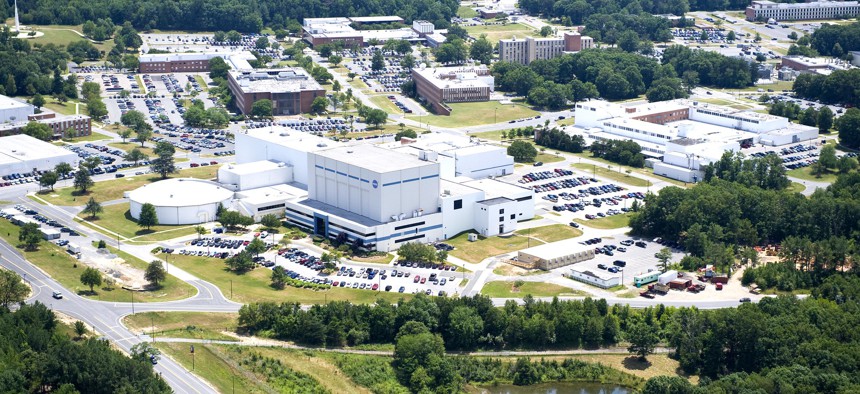sponsor content What's this?

NASA's Goddard Space Flight Center, for which Akima performs facilities, operations and maintenance work. NASA Goddard/Bill Hrybyk
NASA’s Secret Weapon for Maximizing Maintenance Funding to Achieve Higher Levels of Mission Assurance
Presented by

Orbiting high above the Earth’s surface, the Hubble Space Telescope keeps an eye on the universe, observing everything from the birth of distant stars to the clumps of dark matter swirling around the galaxy.
But the finely tuned equipment and high-tech facilities on the ground at NASA Goddard Space Flight Center are just as critical to the mission.
“Quite literally, at any point if those systems go down while they’re working on those missions, data could be lost, and they just can’t afford to have that,” says Greg Monostori, vice president of business development at Akima, which performs facilities, operations and maintenance work for NASA Goddard, the U.S. Air Force and a host of other federal facilities.
When it comes to maintaining critical equipment and systems and optimizing facility performance, NASA relies on an approach known as reliability-centered maintenance.
Rather than performing maintenance based on a static schedule or based solely on how old a particular piece of equipment is, RCM uses a suite of sophisticated sensors and analytics as part of an enterprise-level maintenance strategy to deliver a more predictive approach to maintaining mission-critical equipment.
The idea: Deliver the right maintenance at the right time for the right reason.
Experts say the concept could be applied more broadly across the government — it better optimizes facilities and can deliver big cost-savings.
“Ultimately, it extends the life of your equipment, because you’re not allowing things to get to the point where, potentially, they’re going to fail,” Monostori says. “You’re tackling them at the soonest indication that something’s not quite right.”
More Reliability, More Flexibility
Many programs today rely on the traditional maintenance model — carrying out preventive maintenance, or PM, based on a set schedule.
“However, the equipment may break down in between maintenance visits, because something's gone wrong,” Monostori says. Perhaps there was more wear and tear to a particular piece of equipment than expected or some other anomaly. “You're not going to know that until the system goes down hard,” he adds.
True to its name, RCM provides greater reliability, Monostori says.
“You're monitoring all of these systems and this equipment and you're doing the maintenance when you get indicators from your analysis that maintenance needs to be done to prevent a failure,” he explains.
RCM also provides greater flexibility. Preventive maintenance can be a bit of a blunt instrument—requiring systems to go down for extended periods so repairs and fine-tuning can take place.
“RCM allows me to have a lot more flexibility with our schedule because we’re doing it based on need, not based on a set time frame,” says Victor Hutson, Akima Support Operations program manager at NASA Goddard.
“You analyze the maintenance data that you're getting to predict better when you need to perform preventative maintenance instead of doing it just on a time-based schedule,” Hutson says. “So, it's a much more analytical approach to maintaining equipment.”
Mitigating Risk
Hutson is leading the Akima team that helped roll out the concept at NASA Goddard, where it’s used across the center’s state-of-the-art facilities. In addition to the Hubble Space Telescope, NASA Goddard acts as ground control for a number of critical satellites, including sensors aboard the Mars-exploring rover, Curiosity.
Engineers and scientists are also preparing to roll out the successor to the Hubble, the James Webb Space Telescope, which is expected to launch in 2021.
The work to assemble and integrate the powerful systems that will power the new space telescope is carried out in cleanrooms — tightly controlled environments that rely on critical equipment to screen out pollutants such as dust and other particles that can damage highly sensitive hardware.
If the equipment responsible for keeping NASA’s state-of-the-art clean rooms truly clean goes down, that could compromise the mission even in its earliest stages.
“So, having RCM in place, which mitigates a lot more risk for the customer and allows them to have greater confidence in the reliability of their systems, is vital,” Monostori says.
Gaining Traction
Implementing an RCM approach requires an investment in terms of human capital and in tools and technology such as sensors to measure vibrations, oil levels and other key indicators.
It also requires some patience at first. It takes time to collect and compile data decision-makers need to make smarter maintenance decisions.
“You can't just put on a sensor and then automatically know what it's doing,” Hutson says. “You have to come up with your baseline analysis; you have to see how the equipment's reacting under different load conditions and things of that nature before you can get a dataset that starts to produce for you the things that you need to know to properly apply the RCM concept.”
But the down-stream cost-savings are tremendous, Monostori says.
“And the level of risk associated with operating the equipment goes way down because, just by its very nature, RCM helps to keep the equipment in a more pristine condition,” he adds.
The approach is catching on with other agencies that rely on sophisticated equipment and systems both in civilian agencies that perform research and development work and across the Defense Department.
“With each success story out there about lower down-stream maintenance costs and greater reliability, RCM continues to gain traction,” Monostori says. For agencies with mission-critical requirements, “they're going to see RCM as an enabler and not as a cost,” he says. “It's a risk-mitigation tool and a mission enabler.”



